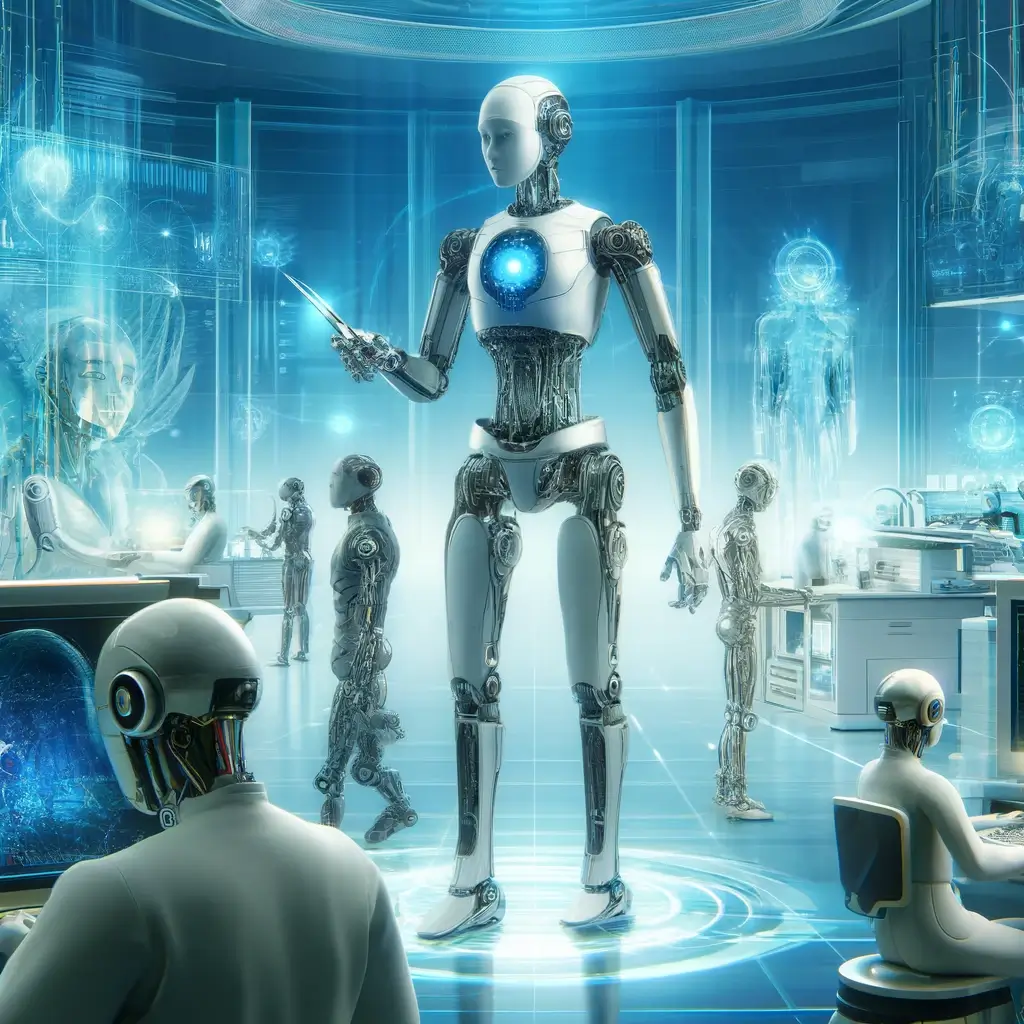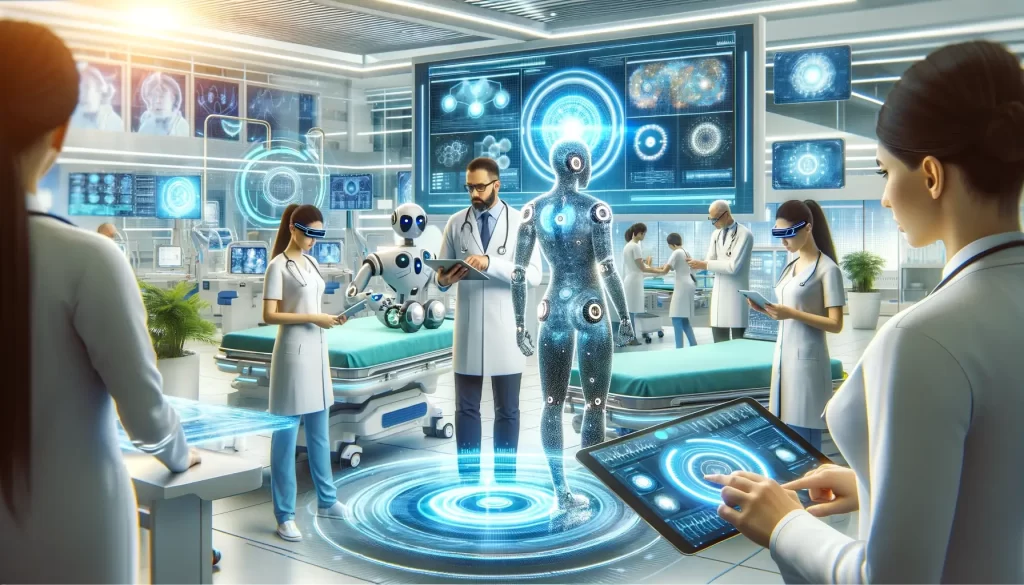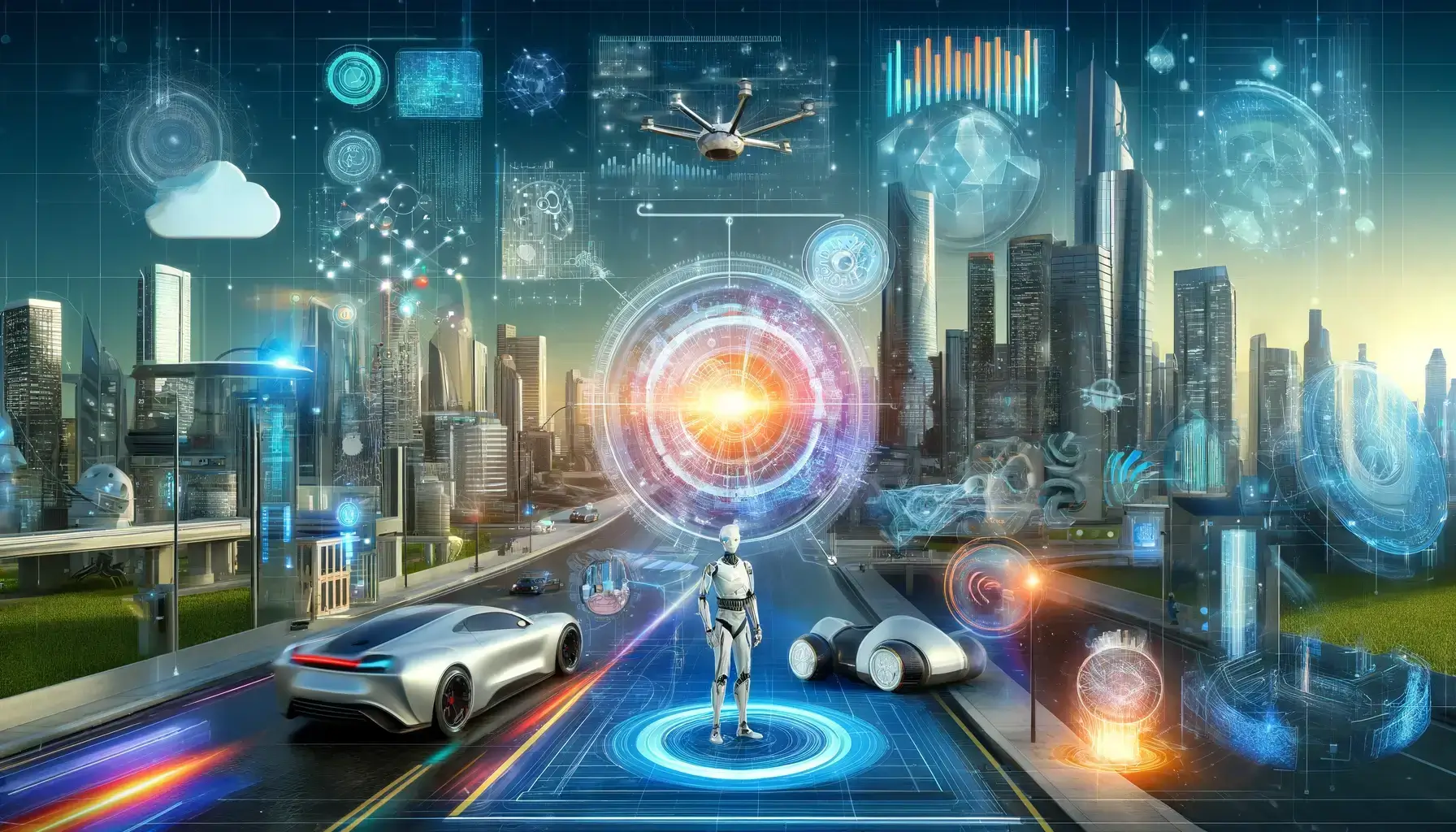Artificial intelligence (AI) isn’t some distant sci-fi fantasy anymore. It’s a rapidly evolving technology that’s transforming our world in profound ways. But beneath the buzzwords and headlines, what exactly can AI do? I this article I will peel back the curtain and unveil the remarkable capabilities that underpin the power of AI. We’ll delve into its core functionalities, exploring how machines are learning to perceive, reason, solve problems, and even communicate in ways that are increasingly sophisticated. So, buckle up and get ready for a mind-bending exploration of what AI can truly achieve.
Machine Learning and AI
Imagine a scenario where machines learn and improve on their own, without explicit programming. That’s the magic of machine learning, a powerful subset of AI that fuels its capabilities. Here’s how machine learning acts as the secret sauce, supercharging the abilities of AI:
Supervised Learning: The Teacher-Student Dynamic
Think of a student diligently studying under a teacher’s guidance. That’s supervised learning in a nutshell. In this approach, machines are trained on massive datasets labeled with specific outputs. By analyzing these examples, the AI learns to identify patterns and make predictions on new, unseen data. Imagine a system classifying emails as spam or not spam based on a vast database of pre-labeled emails. That’s supervised learning in action!
Unsupervised Learning: Finding Hidden Patterns
Now, picture a student exploring a library, uncovering hidden connections and themes amongst a sea of books. That’s unsupervised learning at play. This technique involves feeding unlabeled data to AI systems, allowing them to discover patterns and relationships on their own. For instance, an unsupervised learning algorithm might analyze customer purchase history to identify hidden buying trends, completely autonomously.
Supervised and unsupervised learning work together like a well-oiled machine. Supervised learning provides the initial training and guidance, while unsupervised learning allows AI to delve deeper, uncovering hidden insights and constantly expanding its capabilities. This powerful partnership is what truly unlocks the potential of AI, making it a versatile tool capable of tackling complex challenges across various domains.
Natural Language Processing (NLP)
Ever chatted with a virtual assistant that understood your questions and responded like a real person? That’s the power of Natural Language Processing (NLP) at play. NLP is a subfield of AI focused on enabling machines to understand, interpret, and even generate human language. It acts as AI’s translator, bridging the communication gap between humans and machines.
Here’s how NLP breathes life into AI, allowing it to interact with us in natural ways:
Chatbots: The Conversational Companions
Imagine a tireless customer service rep, available 24/7 and able to answer your questions in a natural, engaging way. That’s the potential of NLP-powered chatbots. By processing and understanding your queries, chatbots can provide information, resolve issues, and even personalize the customer experience.
Translation Tools: Breaking Down Language Barriers
The world is a tapestry of diverse languages. NLP empowers AI to translate between languages seamlessly, fostering communication and understanding across cultures. From deciphering travel documents to translating real-time conversations, NLP bridges the language gap and opens doors to a more connected world.
Sentiment Analysis: Decoding Emotions Behind the Text
Imagine a system that can gauge the emotional tone of a written message. NLP makes this possible through sentiment analysis. By analyzing word choice and sentence structure, AI can understand the underlying sentiment – positive, negative, or neutral – behind emails, social media posts, and even customer reviews. This allows businesses to gain valuable insights into customer satisfaction and tailor their strategies accordingly.
NLP is a game-changer, empowering AI to communicate and understand human language with ever-increasing sophistication. These capabilities are revolutionizing how we interact with machines, opening doors to more natural and intuitive user experiences across various applications.
Computer Vision
Imagine a machine that can “see” the world around it, interpreting visual data with remarkable precision. That’s the realm of computer vision, a branch of AI dedicated to enabling machines to analyze and understand visual information. Just like human vision allows us to navigate our surroundings, computer vision equips AI with the ability to perceive and interpret the visual world.
Here’s how computer vision empowers AI to see and make sense of its environment:
Facial Recognition: Unmasking Identities Through Technology
Ever unlocked your smartphone with a selfie? That’s facial recognition powered by computer vision in action. By analyzing facial features and patterns, AI systems can identify individuals with impressive accuracy. This technology has applications in security systems, personalized marketing, and even photo tagging on social media platforms.
Autonomous Vehicles: Paving the Way for Self-Driving Cars
The dream of self-driving cars hinges on a critical technology – computer vision. AI systems equipped with computer vision capabilities can perceive their surroundings using cameras and sensors. They can identify objects like pedestrians, vehicles, and traffic lights, navigate roads, and even make real-time decisions to ensure a safe and smooth driving experience.
Computer vision is revolutionizing how AI interacts with the physical world. By enabling machines to interpret visual data, it opens doors to a future filled with intelligent machines that can see, understand, and react to their surroundings in increasingly sophisticated ways. This technology has the potential to transform industries like transportation, security, and manufacturing, paving the way for a more automated and intelligent future.
Robotics and AI

Remember those clunky, pre-programmed robots from old sci-fi movies? Those days are long gone. Today, we’re witnessing the powerful integration of AI in robotics, creating a new generation of intelligent machines. This dynamic duo is transforming the way we automate tasks and manufacture goods, pushing the boundaries of what’s possible.
Here’s how AI is breathing intelligence into robots, supercharging their capabilities:
Enhanced Automation: Beyond Repetitive Tasks
Imagine factory robots that can not only perform repetitive tasks but also adapt to changing environments and respond to unexpected situations. That’s the power of AI in action. By equipping robots with AI capabilities, we’re enabling them to handle complex tasks, make decisions on the fly, and continuously improve their performance. This significantly expands the scope of automation, allowing robots to tackle a wider range of tasks across various industries.
Revolutionizing Manufacturing: From Assembly Lines to Smart Factories
The future of manufacturing is smart, and AI-powered robots are leading the charge. By integrating AI with robotics, factories can create intelligent production lines that optimize processes, minimize errors, and ensure consistent quality. Robots equipped with AI can learn from past experiences, adjust to production line variations, and even perform predictive maintenance, preventing costly downtime.
The marriage of AI and robotics is a game-changer. It’s ushering in a new era of intelligent automation, where machines work alongside humans to streamline processes, boost efficiency, and drive innovation across various sectors. This powerful collaboration has the potential to redefine manufacturing, logistics, and even healthcare, shaping a future where machines not only work for us but also work with us.
Predictive Analytics
Imagine having a glimpse into the future, anticipating trends and behaviors before they unfold. That’s the power of predictive analytics, a field where AI excels. By analyzing vast amounts of data, AI can identify patterns, predict future outcomes, and empower us to make smarter decisions across various domains.
Here’s how AI-powered predictive analytics is transforming several fields:
Finance: Charting a Clearer Course in the Market
Financial markets are notoriously complex, riddled with uncertainty. AI-driven predictive analytics helps cut through the noise. By analyzing historical data, market trends, and customer behavior, AI can predict potential risks, identify lucrative investment opportunities, and even personalize financial products for individual clients. This empowers investors and financial institutions to make data-driven decisions and navigate the ever-changing market landscape with greater confidence.
Healthcare: Proactive Prevention and Personalized Care
Predictive analytics is revolutionizing healthcare by enabling early detection and prevention of diseases. AI algorithms can analyze a patient’s medical history, lifestyle choices, and genetic data to predict their risk of developing certain conditions. This allows for proactive intervention, early diagnosis, and personalized treatment plans, ultimately leading to better health outcomes.
Marketing: Tailoring the Message to the Right Audience
In today’s data-driven marketing world, understanding customer behavior is key. AI-powered predictive analytics helps businesses achieve this by analyzing customer data, purchase history, and online interactions. This allows them to predict future customer behavior, personalize marketing campaigns, and target the right audience with the right message at the right time. The result? Increased engagement, higher conversion rates, and a significant boost to marketing ROI.
Predictive analytics is a powerful tool that leverages AI’s processing muscle to forecast trends and anticipate future events. This capability is transforming numerous industries, empowering us to make informed decisions, optimize
AI in Healthcare

Healthcare is on the cusp of a transformative era, fueled by the power of Artificial Intelligence (AI). AI is rapidly becoming more than just science fiction in medicine; it’s a potent tool that’s transforming how we diagnose diseases, personalize treatment plans, and even discover new life-saving drugs.
Let’s delve deeper and explore the exciting applications of AI in healthcare:
Diagnosing with Precision: Seeing What Doctors Might Miss
Imagine an AI system that can analyze medical scans with superhuman accuracy, spotting abnormalities that might escape the human eye. That’s the reality of AI-powered diagnostics. By analyzing vast datasets of medical images, AI can identify patterns and detect diseases like cancer or heart disease earlier and more accurately than ever before. This leads to faster intervention, improved treatment outcomes, and potentially even saves lives.
Personalized Treatment Plans: Shifting the Focus to You
Gone are the days of a one-size-fits-all approach to medicine. AI is ushering in an era of personalized treatment plans, tailored to each patient’s unique needs. By analyzing a patient’s medical history, genetic data, and response to past treatments, AI can predict how they might react to different medications or therapies. This empowers doctors to create customized treatment plans that are more effective and have fewer side effects.
Drug Discovery: Fast-tracking the Fight Against Disease
The traditional drug discovery process is lengthy and expensive. AI is accelerating this process by analyzing vast amounts of scientific data, identifying potential drug targets, and even simulating the development of new medications. This allows researchers to explore a wider range of possibilities in a shorter timeframe, ultimately leading to the development of life-saving drugs at a much faster pace.
AI’s potential in healthcare is vast and constantly evolving. Its ability to analyze complex data, identify patterns, and make predictions is revolutionizing the way we approach medicine. From early diagnosis and personalized treatment to accelerated drug discovery, AI is poised to transform healthcare delivery, improve patient outcomes, and usher in a new era of medical marvels.
AI in Business and Industry
The tide of artificial intelligence (AI) is rapidly reshaping the landscape of business and industry. It’s not just about futuristic concepts anymore; AI is a powerful tool businesses can leverage today to streamline operations, enhance customer service, and make data-driven decisions that drive growth. Let’s dive into how AI is transforming the way businesses operate:
Optimizing Processes: Automating Tasks and Boosting Efficiency
Imagine a world where mundane, repetitive tasks are handled flawlessly by machines, freeing up your employees for more strategic work. That’s the magic of AI-powered process optimization. By automating tasks like data entry, scheduling, and report generation, AI allows businesses to streamline workflows, reduce human error, and significantly boost operational efficiency. This translates to cost savings, increased productivity, and a sharper competitive edge.
Customer Service Redefined: Delivering Personalized Experiences at Scale
In today’s customer-centric world, exceptional service is paramount. AI is transforming customer service by enabling businesses to deliver personalized experiences at scale. Chatbots powered by AI can answer customer questions 24/7, recommend products based on past purchases, and even resolve simple issues autonomously. This frees up human agents to handle complex inquiries, fostering deeper customer relationships and boosting overall satisfaction.
Decision-Making on Autopilot: Data-Driven Insights for Smarter Strategies
Data is the new oil, but what good is oil if you can’t refine it? AI excels at analyzing vast amounts of data, identifying trends, and uncovering hidden patterns that might escape the human eye. This empowers businesses to make data-driven decisions across all aspects of their operations – from marketing campaigns and product development to supply chain management and financial forecasting. With AI-powered insights, businesses can make smarter choices, optimize strategies, and navigate the ever-changing market landscape with greater confidence.
Artificial intelligence is no longer a distant dream; it’s a powerful reality shaping our world today. From its ability to unlock the mysteries of the human brain in healthcare to its potential to revolutionize entire industries, AI is brimming with possibilities. While challenges and ethical considerations remain, one thing is certain: AI is here to stay. As we move forward, embracing AI responsibly and harnessing its potential for good will be crucial in building a smarter, more efficient, and ultimately, a better future for all.
Also Read: Components of Artificial Intelligence

